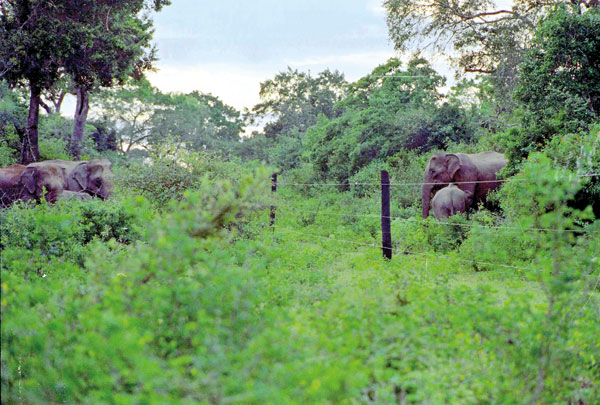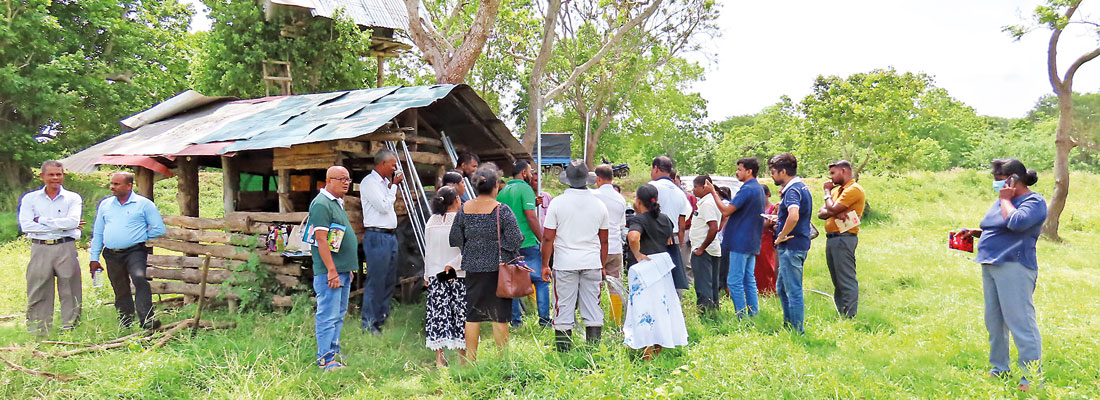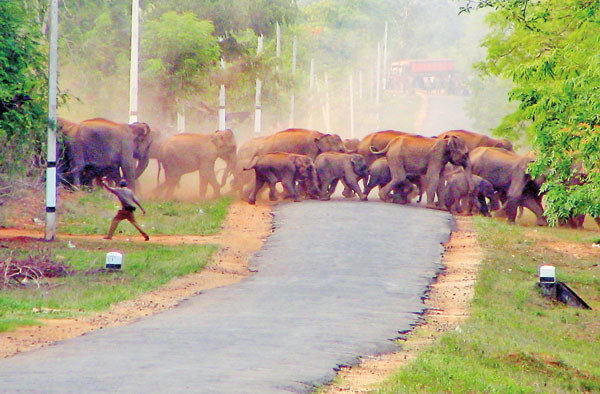News
HEC: Implement the National Action Plan and don’t re-invent the wheel
View(s):- NAP has reduced the human-elephant confrontation, says former DWC DG
By Kumudini Hettiarachchi
Implement the National Action Plan (NAP) for the Mitigation of the Human-Elephant Conflict (HEC) which is based “purely” on science, for it has worked, without re-inventing the wheel.
This is the strong request by the former Director-General of the Department of Wildlife Conservation (DWC), Dr. Sumith Pilapitiya who is spending most of his time away from the comforts of his home in Colombo studying wild elephant behaviour in Minneriya.
As the HEC takes centre-stage in Sri Lanka with numerous solutions being touted by various people, for Dr. Pilapitiya the pathway towards mitigation is crystal clear – the NAP is in place, implement it and adapt it to meet any new ground-level needs experienced while on the run.

A fence on the wrong boundary – with elephants on both sides (Photo courtesy of CCR)
“There is absolutely no necessity to appoint new committees to look into the HEC because it has been done already. The NAP, thrashed out with numerous experts and institutions sitting at the same table, is workable and many segments have proven effective in initial testing,” he reiterates.
Underscoring that the dire need for Sri Lanka’s HEC is a model of co-existence, Dr. Pilapitiya looks back at how the country has been labouring over mitigation since 1959. The “fundamental” difference between the 2020 NAP and all these efforts has been that the latter have not been based on research and science.
Since 1959, the concept followed was to drive and confine wild elephants to Protected Areas (PAs) with wildlife corridors connecting these PAs. When drafting the 2020 NAP, the Presidential Committee had looked at the concept, more than 60 years later, checking out whether elephants had been confined to PAs and whether there had been a reduction in the HEC.

Training of officials of the Agrarian Development Department by CCR (Pic courtesy of CCR)
Research by the Centre for Conservation and Research (CCR) has shown that currently only 30% of elephant range was in PAs and regrettably, there had only been an increase in the HEC, says Dr. Pilapitiya, pointing out that obviously Sri Lanka needed a different concept which would entail managing wild elephants both inside and outside the PAs.
Diving deep into co-existence, he is categorical that it means “sharing” of the landscape between humans and elephants. It does not mean that wild elephants should be in the backyard of humans. Therefore, humans and elephants need to be separated by barriers.
While electric fencing is the most effective barrier, as proven by CCR, the location of such fencing is crucial – it should be on boundaries elephants relate to and not administrative boundaries set up by government agencies. Otherwise, the elephants walk right through these boundaries.

An elephant drive, even though these drives have proved to be futile (Photo courtesy of CCR)
“This is why, the fences should be at the boundary where the natural habitat used by elephants ends and development begins,” says Dr. Pilapitiya, explaining that Sri Lanka has about 5,000kms of fencing, most of which needs to be relocated to ecological boundaries.
Hitting the nail on the head without mincing words, he says that the DWC is having problems when it attempts to relocate the fences to these ecological boundaries due to strong opposition by the public and the politicians. “Therefore, a drastic change in the mindset should come about among politicians and the public.”
Taking the current situation, he says that in the last year, under the NAP, 238 seasonal electric fences, 1,006.1kms in all, were erected through the Agrarian Development Department to protect 11,022 acres of paddy lands benefiting 997 farmer families. How they work is – the fences protect the crops from elephants until the season is over and the harvest is gathered. Then the fences are removed and stored in the villages, allowing the elephants to enjoy whatever is left in the fields. The plans for 2024-25 are an additional 193 seasonal paddy-field electric fences, 740kms in all.
“The fencing in the last year was carried out without any Treasury allocation for implementation of the NAP,” says Dr. Pilapitiya, explaining how the monies for fence material were garnered from the Climate Smart Irrigated Agriculture Project funded by the World Bank (WB) and the Mahaweli Water Security Investment Project funded by the Asian Development Bank (ADB). While CCR provided material for a few selected fences, fencing material had also come through the WB-funded Ecosystem Conservation and Management Project. The staff of the Agrarian Development Department had been trained and implementation assisted by CCR on a pro bono basis.
Dr. Pilapitiya shows how logic held sway with the international funding agencies, the WB and the ADB – “We told them that their investment to safeguard farmers through the Climate Smart Irrigated Agriculture Project and the Mahaweli Water Security Investment Project respectively would come to naught if, whatever yield the farmers produced was ravaged by elephants……that a further logical step would be to protect the yield as well as part of these development projects.”
| How the NAP was born In a commendable first, Sri Lanka had developed the National Action Plan (NAP) for the Mitigation of the Human-Elephant Conflict (HEC) based on science. Long-time elephant expert Dr. Prithiviraj Fernando of the Centre for Conservation and Research (CCR) had chaired the Presidential Committee appointed by then President Gotabaya Rajapaksa in 2020 to prepare the NAP. The stakeholders had been from a wide spectrum – those managing conservation areas such as the Environment & Wildlife Ministry, the Department of Wildlife Conservation (DWC) and the Forest Department; those involved in development and agriculture in areas with elephants hence contributing to the HEC such as the Irrigation Department, Agrarian Development Department and District Secretaries from areas with the HEC; as well as university lecturers working on elephants and elephant researchers. The NAP has also incorporated relevant suggestions from the public. Later, the Presidential Committee tasked with Facilitating and Overseeing the Implementation of the NAP was chaired by Dr. Sumith Pilapitiya and comprised – Dr. Prithiviraj Fernando, representatives of the Ministries of Wildlife & Forest Resources; Public Administration, Home Affairs, Provincial Councils & Local Government; and Irrigation, DWC DG, Conservator General of Forests, Mahaweli Authority DG, Irrigation DG, Commissioner General of Agrarian Development and the Presidential Secretariat’s DG of the Chief of Staffs Office and the Senior Assistant Secretary. The NAP can be downloaded from: http://www.ccrsl.org/userobjects/2873_3191_ActionPlan-English.pdf https://ejustice.lk/national-action-plan-for-the-mitigation-of-human-elephant-conflict-in-sri-lanka-december-2020/
| |
| Elephant drives don’t work – tried, tested and failed!Elephant drives increase the HEC and do not decrease it. As such, continuing to conduct elephant drives is at cross-purposes with HEC mitigation as the way these drives are done results in aggression among the elephants rising, said Dr. Sumith Pilapitiya.”Small and medium-scale elephant drives are mostly conducted due to public and political pressure in the mistaken belief that they will resolve the HEC. Although Sri Lanka has undertaken these drives for decades, there is no area from where elephants have been eliminated by a drive,” he pointed out.Referring to evidence, he picks up the Walawe Left Bank Project elephant drive in the mid-2000s which cost many millions of rupees. A survey by CCR, three months after this elephant drive, had found 71% of the community in the area stating that the problem was the “same” or “worse”. “Therefore, I appeal to the political authorities to implement the NAP fully, rather than take ad hoc decisions or measures that will only aggravate the problem and not solve it,” said Dr. Pilapitiya, adding that it is “sad” that political authorities and even public officials do not learn from past mistakes, but keep repeating the “same tried, tested and failed mechanisms” in the hope that under a new government it may work better.
|
The best way to say that you found the home of your dreams is by finding it on Hitad.lk. We have listings for apartments for sale or rent in Sri Lanka, no matter what locale you're looking for! Whether you live in Colombo, Galle, Kandy, Matara, Jaffna and more - we've got them all!

